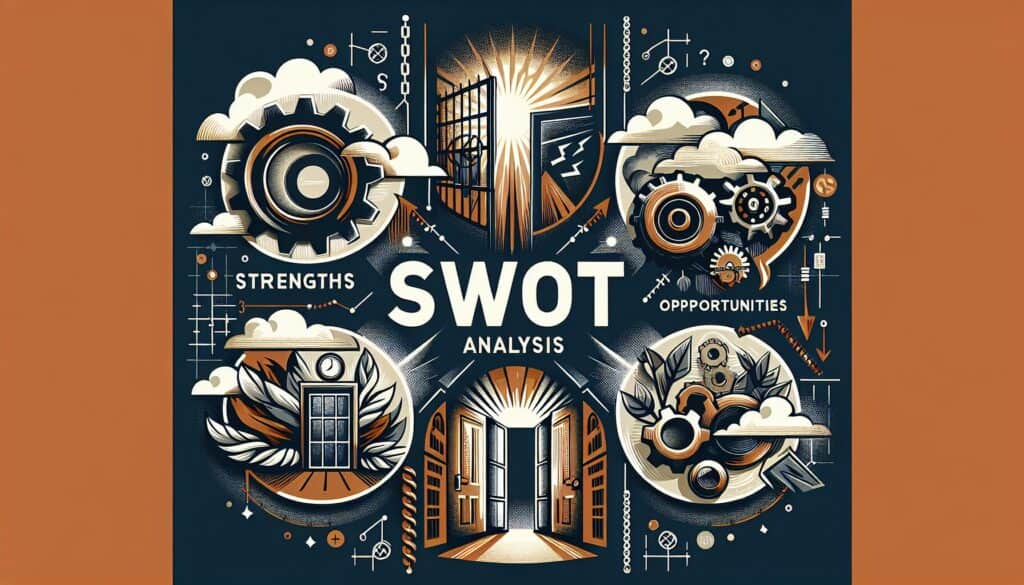Évaluer les forces, les faiblesses, les opportunités et les menaces d'une organisation, d'un projet ou d'un individu afin d'éclairer la planification stratégique.
- Méthodologies : Clients et marketing, Idéation, Conception de Produits
Analyse SWOT

Analyse SWOT
- Business Process Reengineering (BPR), Analyse concurrentielle, Innovation, Étude de marché, Gestion de projet, Gestion des risques, SWOT, Analyse SWOT
Objectif :
Comment il est utilisé :
- Les forces (internes, attributs positifs), les faiblesses (internes, attributs négatifs), les opportunités (externes, facteurs pouvant être exploités) et les menaces (externes, facteurs pouvant causer des problèmes) sont identifiées et répertoriées, souvent dans une matrice à quatre quadrants.
Avantages
- Cadre simple pour organiser la réflexion stratégique ; aide à identifier les facteurs clés internes et externes ; facilite la discussion et la recherche d'un consensus ; peut être appliqué largement à différents niveaux.
Inconvénients
- Peut être subjectif et basé sur des opinions plutôt que sur des données ; peut générer de longues listes sans hiérarchisation claire ; ne propose pas intrinsèquement de solutions ou d'actions ; est statique et peut rapidement devenir obsolète.
Catégories :
- Clients et marketing, Économie, Idéation, Gestion de projet
Idéal pour :
- Planification stratégique, planification des activités, analyse de la concurrence et évaluation de la viabilité des nouvelles initiatives.
SWOT Analysis finds extensive applicability across various sectors including technology, healthcare, manufacturing, and consumer services, often employed during the early stages of project development or strategic planning sessions to evaluate the potential of new product ideas or market entries. Teams made up of product designers, engineers, marketing professionals, and business strategists frequently initiate the SWOT process, allowing for diverse perspectives that can enrich the output of the analysis. In industries such as healthcare, for instance, this method is particularly useful when launching innovative medical devices where understanding both the internal capacities of the organization and the external demands of regulatory compliance and market needs is paramount. The simplicity of the matrix encourages brainstorming sessions that not only identify strengths and weaknesses but also stimulate discourse around how to leverage untapped opportunities—such as emerging technologies or shifting consumer preferences—and mitigate potential threats, including competitive pressures or economic downturns. Organizations can engage in SWOT Analysis at various levels, from a high-level assessment of company strategy to a focused analysis of specific products or initiatives, allowing for flexibility in its application. As a strategic planning tool, it promotes alignment among stakeholders, driving consensus on priorities and enabling teams to formulate actionable plans based on a structured evaluation of both internal capabilities and external market dynamics.
Principales étapes de cette méthodologie
- Identify and list internal strengths relevant to the product or initiative.
- Identify and list internal weaknesses that could hinder progress.
- Identify and list external opportunities that can be leveraged.
- Identify and list external threats that could pose risks.
- Analyze the relationships between internal strengths and external opportunities.
- Evaluate how internal weaknesses can be mitigated by addressing external threats.
- Develop strategic initiatives based on the analysis of the SWOT matrix.
Conseils de pro
- Integrate quantitative data analysis with qualitative observations to enhance the reliability of the SWOT findings.
- Regularly update the SWOT matrix to reflect changes in the market landscape and internal capabilities, fostering agility in strategic responses.
- Involve cross-functional teams in the SWOT analysis process to uncover diverse perspectives and reduce blind spots in assessment.
Lire et comparer plusieurs méthodologies, nous recommandons le
> Référentiel méthodologique étendu <
ainsi que plus de 400 autres méthodologies.
Vos commentaires sur cette méthodologie ou des informations supplémentaires sont les bienvenus sur le site web de la Commission européenne. section des commentaires ci-dessous ↓ , ainsi que toute idée ou lien en rapport avec l'ingénierie.
Contexte historique
1960
1980
1983
1990
1995
2000
2010
1950
1980
1980
1986
1994
1995
2000
(si la date est inconnue ou n'est pas pertinente, par exemple "mécanique des fluides", une estimation arrondie de son émergence notable est fournie)














Articles Similaires
Gestion des opérations de fabrication (MOM)
Système d'exécution de la fabrication (MES)
Plan de contrôle de la fabrication
Tests manuels
Tableaux d'évaluation des manutentions manuelles (MAC)
ManTRA (outil d'évaluation des risques liés aux tâches manuelles)